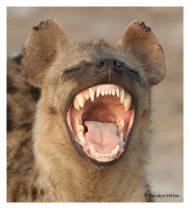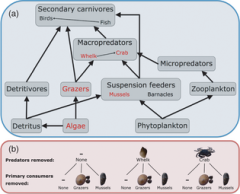
© C. Hilton
Here at ConservationBytes.com, My contributors and I have highlighted the important regulating role of predators in myriad systems. We have written extensively on the mesopredator release concept applied to dingos, sharks and coyotes, but we haven’t really expanded on the broader role of predators in more complex systems.
This week comes an elegant experimental study (and how I love good experimental evidence of complex ecological processes and how they affect population persistence and ecosystem stability, resilience and productivity) demonstrating, once again, just how important predators are for healthy ecosystems. Long story short – if your predators are not doing well, chances are the rest of the ecosystem is performing poorly.
Today’s latest evidence comes from on an inshore marine system in Ireland involving crabs (Carcinus maenas), whelks (Nucella lapillus), gastropd grazers (Patella vulgata, Littorina littorea and Gibbula umbilicalis), mussels (Mytilus edulis) and macroalgae. Published in Journal of Animal Ecology, O’Connor and colleagues’ paper (Distinguishing between direct and indirect effects of predators in complex ecosystems) explains how their controlled experimental removals of different combinations of predators (crabs & whelks) and their herbivore prey (mussels & gastropods) affected primary producer (macroalgae) diversity and cover (see Figure below and caption from O’Connor et al.).

(a) Simplified trophic interaction network of a moderately exposed rocky shore, with the components whose presence was manipulated and highlighted in red. While mussels might not interact trophically with benthic macroalgae consistently, they can comprise important consumers of algal propagules and also have strong non-trophic interactions with macroalgae arising primarily from competition for space on the shore, which might also interact with the presence of grazers. Such strong non-trophic interactions are largely absent from food web-based theoretical frameworks yet play a key role in determining the structure of algal assemblages. While crabs can feed on whelks, no predation by crabs on whelks was observed. (b) Experimental design comprising nine treatments, involving the removal of 2 species of predator and 2 groups of their prey, to measure the independent and interactive effects of predators on primary producers and test for direct and indirect effects across trophic levels.
While there were many complex interactions and outcomes of the removals, the gist of the experiment was that the loss of either predator ended up reducing the diversity and total cover of the macroalgae, mainly via the indirect effects of altered grazing abundance. They also found that shifting the dominance of one prey species to another completely changed the dominance of different macroalgae species. Thus, the top-down effects of predators on primary producers are utterly mediated by the relative changes in prey distribution and abundance. Great stuff.
The paper is worth a read, but has a lot of provisos, methods caveats and the (typical) pleas for more experimental work over longer periods. I’m just sticking with the main message here, but it’s another case of the complexity of ecology and the necessity of trying to examine simple effects from several different angles and under several different circumstances. Yes – we do need a lot more of such studies.
Chalk this paper up as another great example of good empirical evidence for the essential role of predators. Without predators, our feeble attempts to conserve ecosystems are doomed to fail.
CJA Bradshaw.
-34.917731 138.603034
